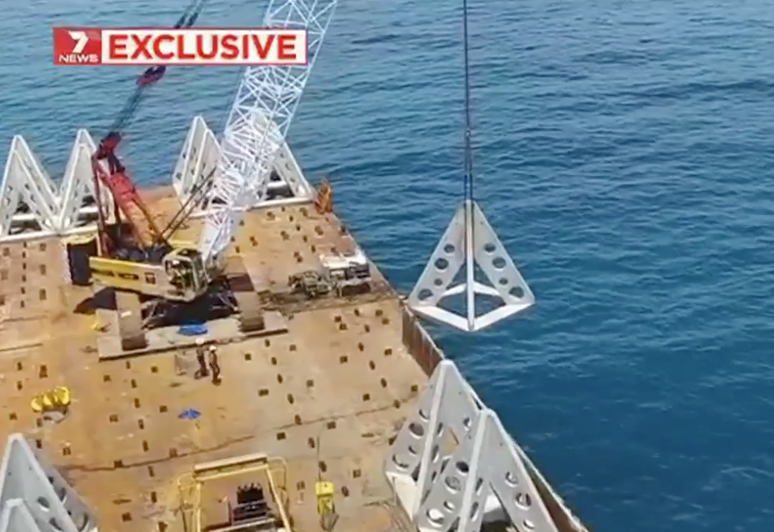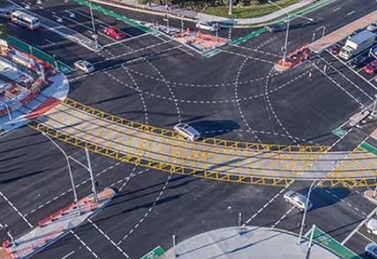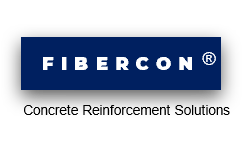Frequently Asked Questions – Design
What is Steel Fibre Reinforced Concrete (“SFRC”) ?
Steel fibre reinforced concrete (“SFRC”) comprises hydraulic cements containing aggregate (fine, or fine and course) and steel fibres. A plasticiser or superplasticiser is often used to enhance mix workability.
Steel fibre products (“SFR” or “steel fibre reinforcement”) are available in a variety of types and sizes from various manufacturers. However, the underlying principle of all SFRC designs is to provide discrete, discontinuous reinforcement and effective crack control.
How do Steel Fibres work?
Unlike wire mesh or rebar, steel fibres reinforce in three dimensions throughout the entire concrete matrix. The fibre functions to reinforce and restrain micro-cracking essentially acting as “miniature reinforcing bars”.
The earlier a crack is intercepted and its growth inhibited, the lower the chance of it developing into a major flaw.
Are Steel Fibres a replacement for structural steel?
The sensible answer is “no”: nothing takes the place of a properly engineered application to code. In structural applications, sufficient continuous steel reinforcement is required to take the full applied tensile load. Among the exceptions to this rule, however, are certain pre-cast applications. Steel fibre reinforcement may be used in conjunction with structural steel.
What properties of the concrete are improved by using Steel Fibres?
Steel fibre reinforced concrete acts as a uniform composite material. Compared to plain or conventionally reinforced concrete, the most immediate differences are improved ductility and post-crack performance.
The specific effects on matrix mechanical properties greatly depend on the type and quantity of fibre used. Generally speaking, smaller fibres with a high fibre count offer superior first-crack strength and better fatigue endurance. Should a crack open widely, longer fibres with mechanical anchorage mechanisms offer better post-crack performance.
What specific concrete properties does steel fibre technology improve?
- Flexural Strength – significant increase (1.5 to 3.0 times) in the first-crack and ultimate flexural (bending) strength can be achieved over plain concrete with higher dosage rates of shorter fibre products.
- Fatigue Resistance – the fatigue strength of steel fibre concrete is far greater (1.6 times) than that of conventional concrete.
- Impact– steel fibres greatly increase (1.5 to 5.0 times) concrete’s resistance to damage from heavy impact.
- Shear Strength – shear strength is much improved (1.25 to 2.0 times) over unreinforced concrete.
- Shrinkage– although the steel fibres themselves do not affect shrinkage rate, they can minimise and help eliminate shrinkage cracks, particularly in a restrained situation.
- Abrasion– steel fibres do not affect the abrasion rate of concrete mortar itself. But they do offer a high degree (1.2 times) of protection against heavy duty abrasion and gouging.
- Spalling is dramatically reduced.
- Permeability – again, steel fibres do not directly affect concrete permeability. But by effectively controlling micro-cracking – and the resulting susceptibility to moisture and chemical penetration – SFR can help reduce the overall porosity of the matrix.
If SFRC is so good, will it entirely eliminate cracking ?
Nothing protects against bad materials and methods and nothing can entirely eliminate cracking. SFRC offers an extremely effective means of controlling cracks – and can substantially reduce opportunities for cracking. Design and installation practices can yield unpredictable results. That’s why optimal attention to product selection, engineering, sub-base preparation, joints, and curing are so essential to overall project performance.
Can Steel Fibre slabs be substantially thinner?
Steel fibre reinforced slabs can be designed in a couple of different ways. Using the more conventional elastic state theory (Westergaard), if the critical load on the slab is static the slab thickness will be much the same as with traditional materials. But if the critical load is dynamic, SFRC’s vast improvement in fatigue resistance can justify a lower safety factor.
The resulting slab can be as much as 25% thinner for the same load carrying capacity.
What about the use of plastic state design method?
The exceptional post-crack performance of SFRC does permit use of a plastic state design method, such as Myerhof, which will, in turn, allow substantial reductions in slab thickness. However employing this type of design approach can result in radial cracking under the load, as well as increased slab deflection.
What is the typical dosage rate?
SFRC dosage rates depend on the application and the concrete properties required.
Typically, 20 – 50 kg/m3 will satisfy most requirements. Lower dosages tend to be used when replacing conventional steel mesh. At higher concentrations vastly improved mechanical strength properties allow SFRC to be used in the most demanding applications.
How does SFRC lower costs over the installation’s life?
Depending on the type, quantity and complexity of reinforcement in traditional design, SFRC can offer substantial cost savings. On occasions, initial costs of steel fibre alone might be slightly higher, but when labour, time, material and activities savings are considered, SFRC costs per m2 actually diminish. Moreover, the superior performance of steel fibres concrete often results in reduced maintenance expense over the installations’ life – further lowering “whole life” project costs.
How should Steel Fibre specifications read?
The following phraseology is all you need to secure the benefits of steel fibre technology: “Steel fibre reinforcement shall be added to the concrete at a rate of _________ kg/m3. Steel fibre shall meet all requirements of ASTM A820-90 type 1. The fibre shall be made from deformed steel wire with a tensile strength in the range of 800-1000 Mpa and have sufficient ductility to permit 180 degree bends without rupture. Fibres shall have an aspect ratio in the range of 40 to 50 and a length of 38 mm.”
What is the difference between Synthetic and Steel Fibres?
Synthetic fibres mainly help control plastic shrinkage cracking, which can occur in the very early stages of concrete life. Steel fibres reinforce the concrete in its hardened state, thereby improving its strength and durability. The major difference between steel and synthetic is their respective Young’s modulus and tensile yield strength. Steel fibres have a sufficiently high modulus of elasticity and tensile strength to assume excess strain across a crack – and hold it tightly.
Application
Save Time & Money With FIBERCON. We will engineer your solution- Leader in Steel and Macro Synthetic Fibres
- Custom fibre designs and packaging available
- Excellent crack control
- Superior installation performance
- Unequaled cost-effectiveness
- No handling or finishing problems
- Variety of standard types and sizes available
- Engineering and design assistance available...
Case Studies

FIBERCON fibres were chosen for Stradbroke Island artificial reef

Magnetic Island Walkway protected against salt corrosion

FIBERCON MP47 was chosen for Gold Coast Light Rail Project
Subscribe to our Newsletter
Keep up to date with the latest on our product developement and what’s new in the industry






